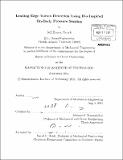| dc.contributor.advisor | Michael S. Triantafyllou. | en_US |
| dc.contributor.author | Dusek, Jeff Ernest | en_US |
| dc.contributor.other | Massachusetts Institute of Technology. Dept. of Mechanical Engineering. | en_US |
| dc.date.accessioned | 2012-01-30T17:04:38Z | |
| dc.date.available | 2012-01-30T17:04:38Z | |
| dc.date.copyright | 2011 | en_US |
| dc.date.issued | 2011 | en_US |
| dc.identifier.uri | http://hdl.handle.net/1721.1/68939 | |
| dc.description | Thesis (S.M.)--Massachusetts Institute of Technology, Dept. of Mechanical Engineering, 2011. | en_US |
| dc.description | Cataloged from PDF version of thesis. | en_US |
| dc.description | Includes bibliographical references (p. 115-116). | en_US |
| dc.description.abstract | The increasing global demand for energy has placed emphasis on the development of innovative renewable energy sources. Ocean energy technologies, while currently underutilized worldwide, promise to emerge as an important part of a comprehensive global energy solution. Recently, research on the energy saving Kairmain gaiting motion employed by fish in the wake of obstructions, has inspired studies into the use of flapping foils as an alternative to traditional turbine geometries in shallow and turbulent environments. While studies have shown that fish can passively synchronize with vortices shed behind an obstruction, the ability to maintain the Kairmin gaiting motion requires sensory feedback and active control. Our research focuses on the detection of leading edge vortices (LEV) shed from a hydrofoil undergoing both steady translation and flapping foil motions. A NACA 0018 foil was instrumented with four pressure sensors to allow the pressure field near the foil surface to be sampled throughout the foil motions. In addition, PIV techniques were used to image the flow field and verify the presence and location of vortex structures independent of pressure measurements. It was found that the shedding of a LEV created a strong, easily distinguishable pressure signature that was observed sequentially on each pressure sensor location as the vortex translated from the foil leading to trailing edge. Force and moment measurements were also made during steady translation experiments, demonstrating the presence of a transient increase in lift force and an additional pitching moment due to the presence of a LEV near the foil surface. Results demonstrated that employing real-time pressure sensor measurements as feedback to the motion control of a flapping foil device has the potential to increase energy extraction efficiency through the optimal synchronization of foil motions and near-body vorticity. | en_US |
| dc.description.statementofresponsibility | by Jeff Ernest Dusek. | en_US |
| dc.format.extent | 116 p. | en_US |
| dc.language.iso | eng | en_US |
| dc.publisher | Massachusetts Institute of Technology | en_US |
| dc.rights | M.I.T. theses are protected by
copyright. They may be viewed from this source for any purpose, but
reproduction or distribution in any format is prohibited without written
permission. See provided URL for inquiries about permission. | en_US |
| dc.rights.uri | http://dspace.mit.edu/handle/1721.1/7582 | en_US |
| dc.subject | Mechanical Engineering. | en_US |
| dc.title | Leading edge vortex detection using bio-inspired on-body pressure sensing | en_US |
| dc.type | Thesis | en_US |
| dc.description.degree | S.M. | en_US |
| dc.contributor.department | Massachusetts Institute of Technology. Department of Mechanical Engineering | |
| dc.identifier.oclc | 773748635 | en_US |
